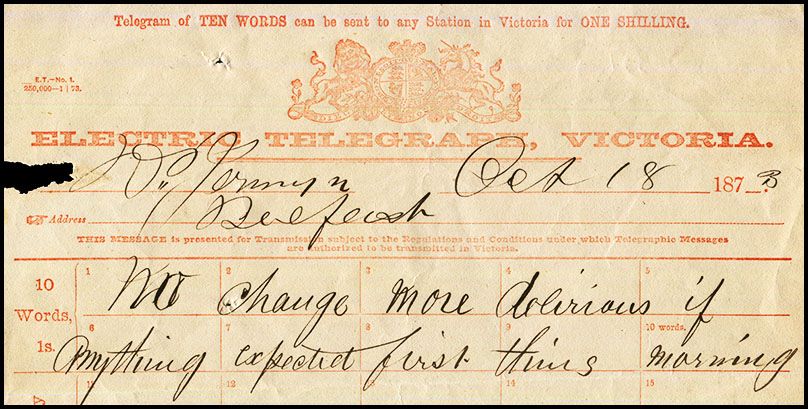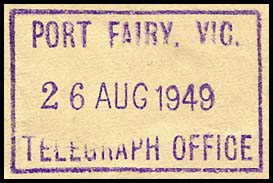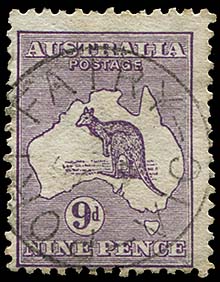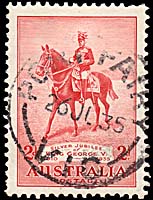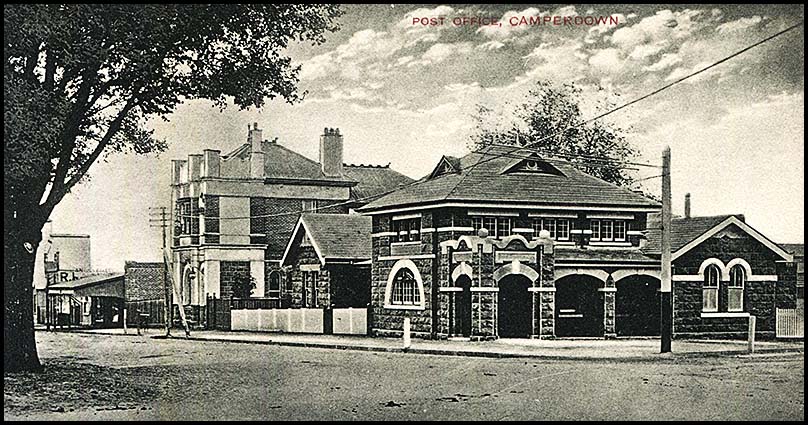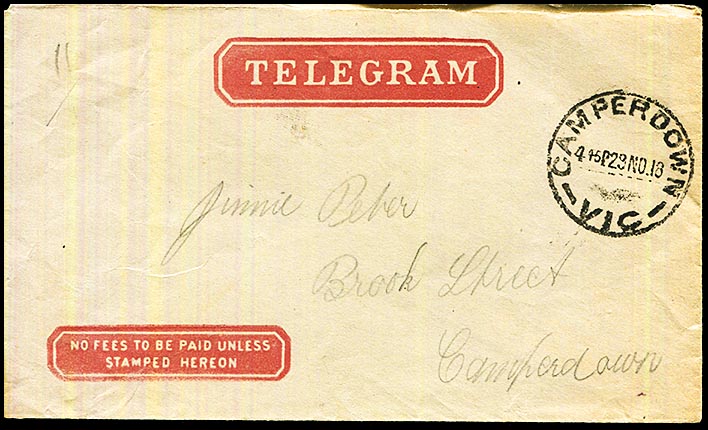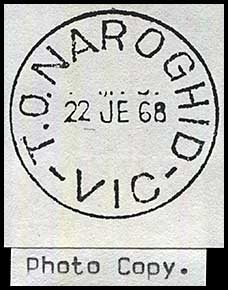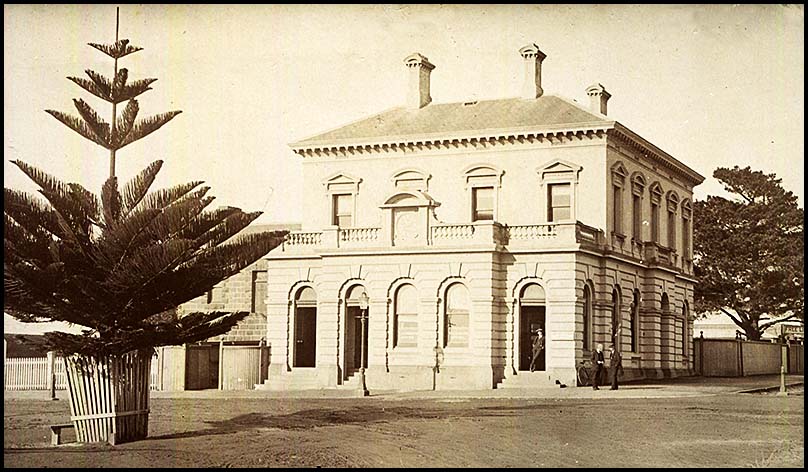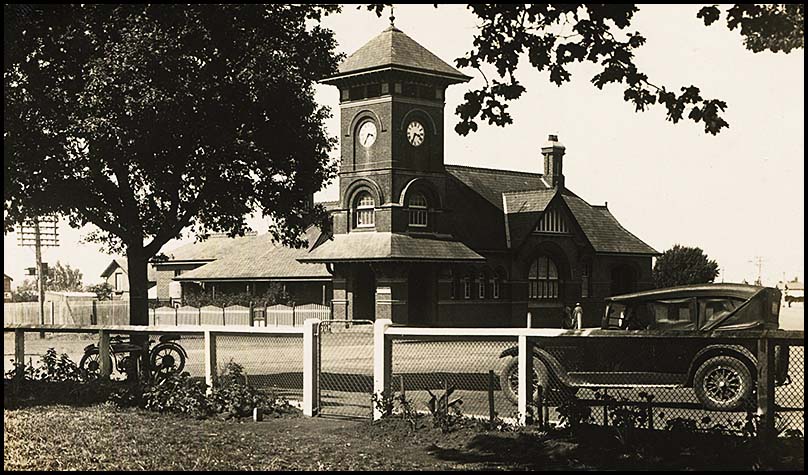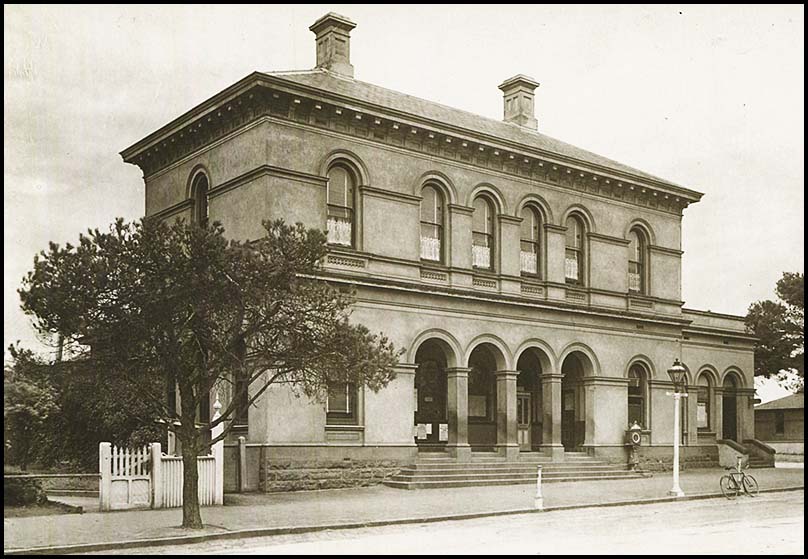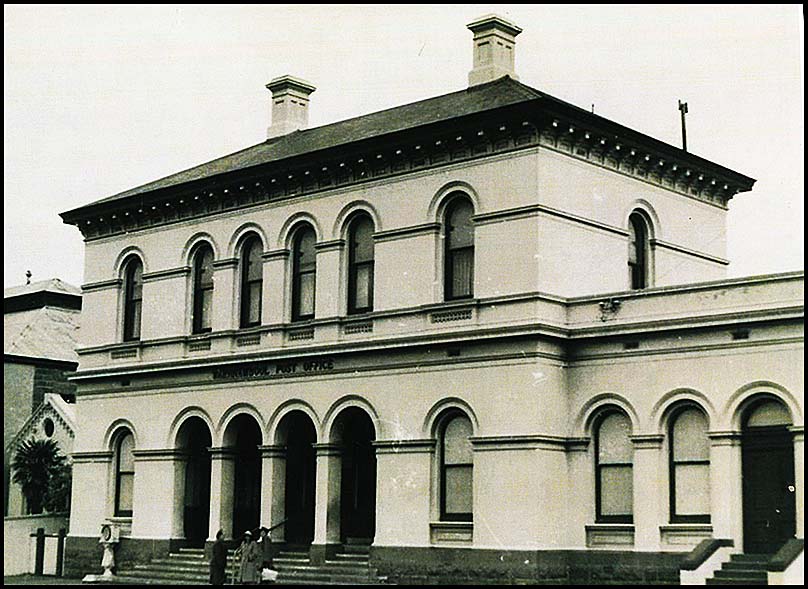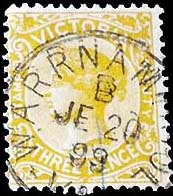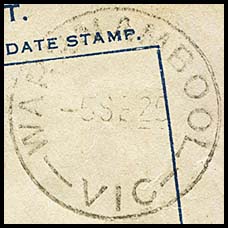Telegraph Offices on the Mount Gambier Line.
- Australia 1901-1988
- New South Wales
- Overview of NSW
- Telegraph lines
- Telegraph Offices
- Date stamps
- Forms
- Envelopes
- Instructional annotation
- Collect
- Delayed
- Free
- Immediate Urgent
- Reply paid
- Rates
- Stamps
- 1871 Telegraph stamps
- 1885 proposal
- 1893 proposal
- Queensland
- South Australia
- Tasmania
- Victoria
- Western Australia
- International
- Special aspects
The following Telegraph Offices are accessed from this page:
| Allansford | Beeac | Belfast | Camperdown | Colac | Cudgee |
| Dixie | Eurack | Koroit | Lismore | Naroghid | Pomborneit North |
| Port Fairy | Portland | Stoneyford | Terang | Warrnambool |
|
The Telegraph Office opened in October 1882. No special date stamp was issued for telegraph used A Telegraph Office opened at the Railway Station about 1915 but closed in the same year. |
|
On 6 May 1887, the Colac Herald reported "A deputation from the Beeac district was introduced on Wednesday to the Postmaster-General by the Hons. J. H. Conner and F. Ormond, Ms.L.C. and Mr. Forrest, M.L.A. A request was made for a Post and Telegraph office to be established at Beeac. The Postmaster-General promised to establish a two-thirds time office, provided the inhabitants of Beeac guaranteed to pay the loss, if any, incurred. The total cost of the office would be £226 per annum, half of which the residents of Beeac will have to defray. This proposal, we may add, will be accepted by the people interested". The Colac Herald of 8 February 1889 printed a letter to the Editor it had received: POSTAL FACILITIES AT BEEAC. Sir, Seeing an explanation by Mr. A. Purse in your esteemed journal of February 1st re our telephone, I would, with your permission, like to say a few words thereon. It is undoubtedly the fact that Mr. Purse acted according to his legal acquirements but we all have to admit that there is a higher law than that written in the Victoria Statute Book. It is even higher than Bismark's favourite dictum; it is a law written in Love - " Do as we would be done by." But the portion of Mr. Purse's explanation I wish to draw attention is a portion of the last paragraph. It runs thus "The office, I may say, is not allowed a messenger". Now, Mr. Editor, I would like to ask how it is that a district of such importance as this and a town that is growing to be capable of much expansion, has foisted upon it a telephone in a store and a Post Office in a store? Why, Sir, this sort of a mixed concern? Why not a separate Post and Telegraph Office? We up here are inclined to resent this sort of thing, and we intend asking our representative how it it is that he has neglected our interests so long in this respect. Possibly Mr. Purse may contend that the office is not in the store but to all intents and purposes it is so as everything has to pass through the hands of the storekeeper or his assistants. Now, Sir, we contend
Kindly excuse this trespass upon your space. At the monthly Meeting of the Beeac Progress Association for July 1915, the President tabled correspondence "from the Postal Department intimating that the Department will consider the question of installing a Morse telegraph instrumcnnt at the Beeac P.O.". The Camperdown Chronicle of 18 September 1915 reported progress: "As a result of representations made by the Progress Association to the Postal Department through Mr Manifold, M.H.R., it has been decided to install a Morse telegraph instrument at the Beeac Post Office. This would be welcome news to the residents because, in addition to securing privacy for all telegrams transmitted and received, it will also relieve the congestion on the telephone between Beeac and Colac, and avoid delays which have occurred in the past". An unusual juxtaposition of the two types of communication. In 1885, the Postmaster at Beeac received a salary of £64 per year. |
|
The Telegraph Office opened on 13 March 1858. The tender for the erection of the Telegraph Office at Belfast had been let in December 1857 to John Mason for £963. The Post Office was renamed Belfast from Port Fairy on 1 January 1854 and was renamed back from Belfast to Port Fairy on 20 July 1887. On 14 February 1860, the Legislative Assembly objected to the amalgamation of the Belfast Post Office and Telegraph Office. The Government, however, carried the amalgamation by 28 against 23. The earliest evidence of the operation of the Belfast Telegraph Office is a telegram transmission form (VC-TO-5) used at an office (which is not identifiable) for a message to Belfast on 18 October 1873. |
||
|
||
Personnel: July 1886: Mr. Thwaites, who had occupied the position of Post and Telegraph Master at Belfast, was transferred to the corresponding position at Sale. |
||
| Two formats of date stamp were issued to the Office for use with telegraphic matters. | ||
|
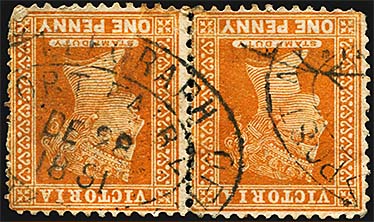 28 December 1891. Used on pair 1d. brown Naish design. |
|
|
|
|
|
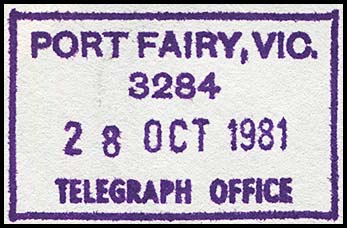 28 October 1981. |
|
| Port Fairy/VIC postal date stamp. Postal date stamp |
|
|
On 18 January 1861, a major thunderstorm hit Belfast. The Banner reported as follows:
"On Tuesday morning, about 3 a.m., this town was visited with a thunderstorm exceeding in intensity anything previously remembered in these parts. For two hours, the cloud was in fearful proximity to the town, the lashing of the lightning and crashing of the thunder being almost incessant. A chimney in the house of Captain Grant was split from top to bottom by the electric fluid; in the Telegraph Office, constant watch had to be kept as the wires at the termination were at white heat and finally fused whilst the panelling was ignited in four or five places. The sight of the sparks running to and fro on the wires was very beautiful, and we believe to their conducting properties may be attributed the fact that no further damage was done. A singular feature in the storm was its suddenness".
It is not recorded if the Telegraph Operator also thought the sparks made a beautiful sight on his equipment.
| Camperdown.
The Telegraph Office opened in October 1863 although, in answer to a question in the House, the Chief Secretary had indicated it would open "on the 16th (September) or at least by the end of the month". The appointment of John Duigan to be manager of the Electric Telegraph and Collector of Imposts and also to act as Postmaster at Camperdown from the 1st October, was Gazetted on 9 October 1863. The Camperdown Chronicle of 8 December 1888 revealed, with a degree of pride, that "The messengers in the Camperdown Post and Telegraph office now wear very neat-looking red jackets which render them conspicuous objects when on their rounds delivering letters or telegrams". |
|
|
|
| The Border Watch of 22 August 1942 reported the following newsworthy item:
"Camperdown now has a girl telegraph messenger - Nancy Robins, 15-year-old daughter of Mr. and Mrs. W. Robins, who began delivering telegrams on Monday, using a bicycle. Nancy is training as a telephonist, but when the messenger, Patrick Slattery, got measles, someone had to take his place and Nancy is filling the bill well according to the post office officials. Until recently she was working in a glass factory in Geelong". |
|
Camperdown was issued with a two hole Belt & Buckle date stamp. |
|
|
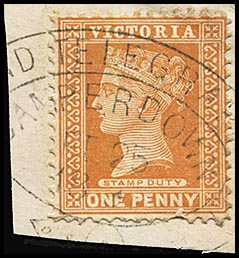 25 February 1893. Latest recorded date. |
|
|
|
The Telegraph Office opened in the Post Office in August 1863. On 28 August 1863, Edward Smith was Gazetted to be the Manager of Electric Telegraph and Collector of Imposts and also to act as Postmaster at Colac from 20th August, 1863. The Geelong Advertiser reported on 4 July 1863 that "The Old Court House and Police quarters at this place, which were wooden structures, have been lately removed a few yards and placed in a contiguous position fronting the main road. These buildings, which have since then undergone a thorough repair and additions made to them, now appear quite renovated and form the future Telegraph and Post Office together with a residence. The building as it now stands presents a neat, commodious and somewhat showy appearance and is fit to receive an occupant for whom the inhabitants of the district are anxiously looking but probably their patience will be well tried before the appointment of a postmaster for the place will arrive at that stage of routine when the last measure of red tape is attached on its issue from the Circumlocution Office". The Post Office had opened on 1 July 1848 as Lake Colac and was renamed Colac in 1854. On 3 July 1867, the Geelong Advertiser noted "The offices and residence of the Postmaster and Telegraph Manager are being overhauled and painted. Instead of spending the public money periodically in patching up dilapidated buildings, it would be more advisable for the government to erect a stone or a brick structure, suitable to the requirements of our rising township and important district". The 1869 closure The Geelong Advertiser of 18 January 1869 reported "Early this week a notification was received hy the telegraph manager (Mr Weston) that he was to hold himself in readiness to be relieved and that the telegraph office would be closed unless the public guaranteed the defioiency of working same ... The next day Mr. Dunderdale, clerk of petty sessions and land officer, was instructed to hold himself in readiness for change of residence to Port Albert. On the contents of the above letters being made known, the public were indignant. In the first case there is a deficiency of about £80. In the other case Mr Dunderdale, through his knowledge of the law, has enabled the Government to save the expense of a stipendiary magistrate, and instead of being removed he should have had an assistant, for during the last three years the duties of land officer have been nearly enough for one officer to attend to. Both officers have been for over eleven years in the Government service - have been tried and not found wanting. If anything can be done to stop what is proposed, it will be doge, as the public will hold a meeting tomorrow night to discuss the matter. There is no mistake about their being unanimous and if a deputation cannot bring about the desired effect, we must wait until Parliament meets and see what is what and who is who. Yerily there is a medium in all things bnt this, it seems, does not apply to Ministers of "Loyal Liberal extraction". The Geelong Advertiser of 20 January 1869 reported "In my last communication, I alluded to the action taken by the Government in closing the Telegraph Office and removing the clerk -of Petty Sessions. A meeting of the public was held at the Temperance Hall on Saturday evening last to discuss the matter. The chair was occupied by A. Dennis, Esq.J. P. ... The closing of the Telegraph Office, unless a guarantee were given, was the first matter discussed and resolutions were carried unanimously to this effect. That the closing of the Telegraph Office at Colac would be injurious to the prosperity of the district. 2. That the petition read be signed by the chairman and adopted. 3. That the petition be for warded to J. H. Connor, Esq., M.P., for presentation to the hon. the Postmaster General. The petition is as follows, viz "To the Hon. G. V. Smith, Postmaster General for the colony of Victoria. The petition of the undersigned residents of the town and district of Colac respectfully sheweth that your petitioners hear with extreme surprise that it is the intention of Government to discontinue the electric Telegraph Station at Colac. The township of Colac—being the centre of a large population, and situated thirty miles from any other Telegraph Office—the closing of that station would be a serious inconvenience and very detrimental to the advancement of the district. Your petitioners notice that the sum of £260 6s 10d is charged for last year's expenditure—a sum which appears to them heavy considering that the office is combined with the postal department. Your petitioners also notice that the Colac office is only credited with £82 0s 3d for revenue, but beg respectfully to draw your attention to the fact that the closing of that office would reduce the general receipts of the department by another sum of a similar amount received at other offices for messages transmitted here. Your petitioners consider that the fact of individual offices not paying the whole of their working expenses should not in any country, much less in a new and rising colony, necessitate their being abolished, and they trust that same arrangement may be made to continue the Telegraph Station at Colac, and by a reduction of the expenditure render the guarantee unnecessary. And your petitioners will ever pray. Alex. Dennis, chairman of a public meeting held at Colac, Jan. 16,1869, for the purpose of petitioning Government against the removal of the electric telegraph station ; Thomas Rae, J.P., for the bench of magistrates at Colac; E. B. Gilbet, for the Colac Shire Council." On 2 February, the same source followed up with "It is possible the telegraph office will be continued here. In reply to the petition we are informed that no change will be made until after Parliament meets. Do the present Ministers imagine they will be able to hold office after that period?". On 11 March 1869, the Colac Shire Council passed a motion to send a letter to J. H. Connor thanking him for his exertion in successfully remonstrating with the Government against the removal of the Telegraph Station at Colac. On 30 May 1868, The Australasian reported: "Charles Henry Toms, a lad employed at the Colac Post Office and Telegraph Station, has been committed for trial on the charge of stealing four £1 notes from a registered parcel passing through the Post Office. Evidence showed that the parcel had been made up by Mr. H.T. Riddell, teller in the National Bank, Geelong, on the 8th inst. He addressed it to the Colac branch. It contained notes to the value of £700. It was registered and despatched. The parcel was delivered by the prisoner to Mr. Bayertz, the Manager of the local bank. On examination, it was found that the parcel had been tampered with and four notes were missing. These were afterwards traced to the hands of the prisoner". In 1883, Police Quarters and the Court House were converted into the Post and Telegraph Offices.
A Telegraph Office opened at the Railway Station in August 1878. |
||
Personnel: May 1879: Mr. Riley was the Telegraph Operator at Colac. 1885: the Postmaster at Colac received a salary of 300 per year, the telegraph Operator received £216 and the three Messengers received £70 4s, £52 and £24 respectively. |
||
The Telegraph Office was issued with a 1 hole Belt & Buckle date stamp.
|
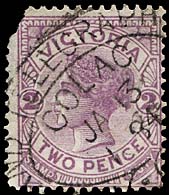 13 January 1884. (Earliest recorded date). |
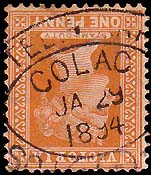 29 January 1894. |
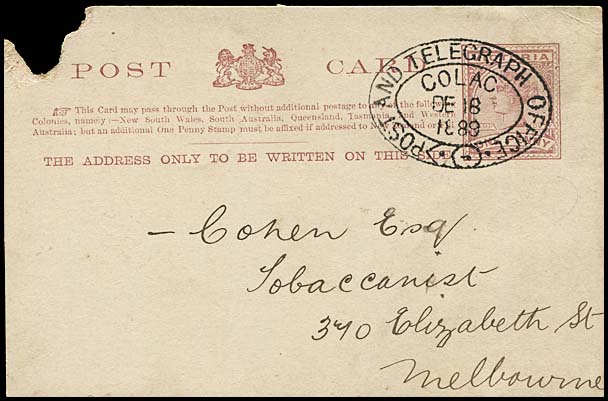 |
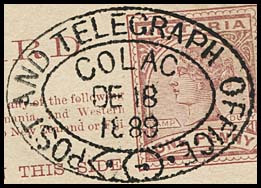 18 December 1889 on a 1d pre-printed Post Card to Melbourne. |
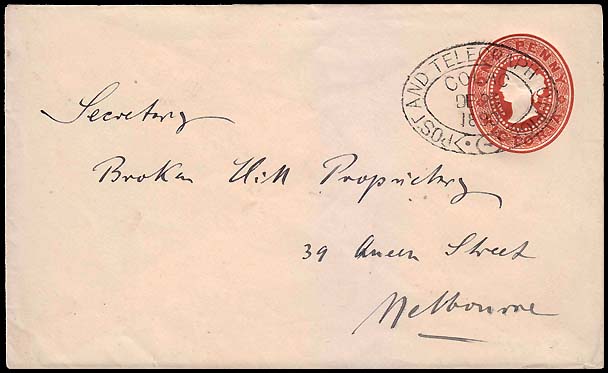 |
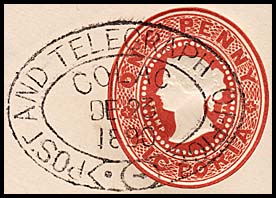 23 December 1890 of a 1d embossed envelope sent to BHP in Melbourne. |
|
||
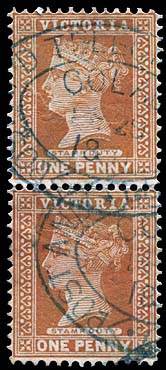 29 December 1890. |
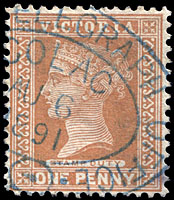 6 August 1891. |
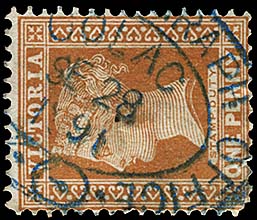 28 September 1891. |
| About 1983, a rubber rectangular TELEGRAPH SECTION date stamp (RRH1-TS) was used in violet. Size: 25 × 42 mm. Rated RR. |
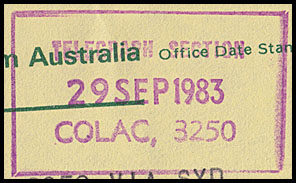 29 September 1983. Used on AT-DO-14C. |
|
The Telegraph Office opened in November 1878. |
|
The Telegraph line to Dixie was a short (8 km) branch from Terang. The office was opened as a R.O. on 18 August 1907 and upgraded to a Post Office on 15 August 1919. It closed on 31 December 1957. |
||
A T.O. date stamp was issued to the Dixie office. Two distinct formats are recorded:
|
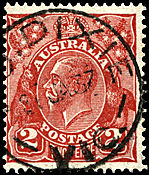 21 January 1937. Showing base and separation arcs. |
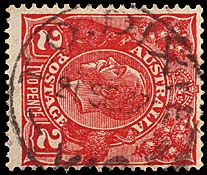 21 September 1937. Showing top inscription. |
|
||
|
Eurack is about 24 km north east of Colac and east of the line joining Colac and Cressy. A Post Office is reported to have been opened at Eurack on 1 July 1905 when the Eurack Creamery was renamed. That Office was closed on 29 April 1961. There has previously been no record of a separate Telegraph Office being opened at Eurack. However, the Camerdown Chronicle of 1 May 1919 carried the following story:
|
|
The Office was issued with a T.O. date stamp:
|
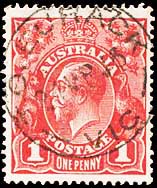 24 March 1916. |
|
The Telegraph Office was opened in September 1872. |
|
|
The Telegraph Office opened about 1 March 1884. |
|
A Post Office was opened named Marida Yallock on 1 October 1875 It was closed on 29 September 1964. A Telegraph Office was opened on 16 August 1928 and it was closed on 20 June 1968. |
||
The Office was issued with a T.O. date stamp:
|
No example of this date stamp being used is recorded. |
|
| Pomborneit North.
The telegraph line passed by Pomborneit North east of Camperdown on Lake Corangamite above Stoneyford. It may have been constructed from a point midway between Colac and Camperdown. The Office was opened as a Receiving Office on 1 February 1910 and changed to a Post Office on 1 December 1923. |
||
A T.O. date stamp was issued to the Office in 1922. Four formats were recorded:
|
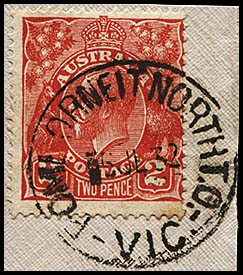 25 July 1932. |
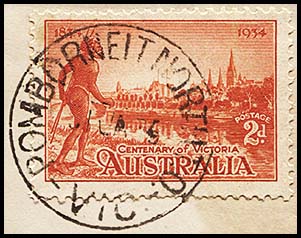 Date unclear. |
|
||
|
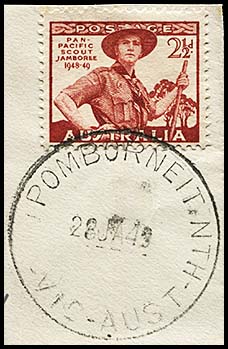 28 January 1949. |
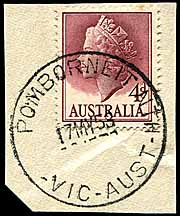 17 May 1958. |
|
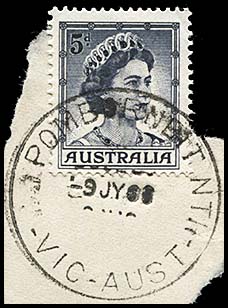 9 July 1960. |
|
| Port Fairy - see Belfast. |
| Portland.
Tenders for a Telegraph Station at Beechworth closed on 3 November 1857 and the Office was opened in February 1858. The Age of 27 December 1865 noted that "Mr Croft, of the telegraph office, has been suspended. Much regret is felt, as this gentleman had earned a character by his invariable good conduct and obliging disposition". On 1 February 1861, the Gazette announced that Walter Burkitt was being transferred from Crewsick to be the Manager of the Telegraph Office at Portland as from 1 January 1861 in lieu of H. Burkitt. |
||
|
||
| The Office was issued with two formats of date stamps for use with Telegrams: | ||
|
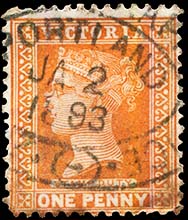 2 January 1893. |
|
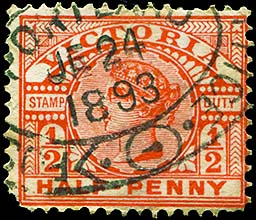 24 June 1893. |
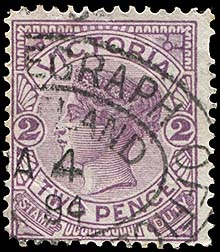 4 January 1894. |
|
|
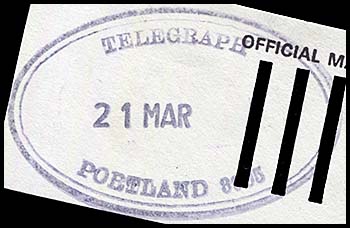 Portland Telegraph. 21 March (no year slug). |
|
| Stoneyford.
The telegraph line passed by Stoneyford midway between Colac and Camperdown. The Telegraph Office was located at the Railway Station. In 1890, the Office transmitted 201 messages and received 273. |
|||
A T.O. date stamp was issued to the office and used with two formats:
|
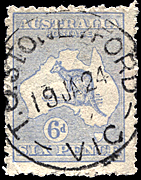 19 January 1924. |
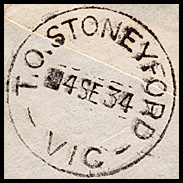 4 September 1934. |
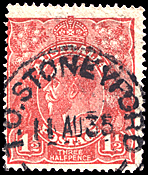 11 August 1935. Latest recorded date. |
|
|||
| Terang.
The telegraph line was connected to Terang on Saturday 4 November 1871 and the Telegraph Office opened immediately. On 13 August 1872, the Herald informatively and fully reported "A young lady has been appointed to the office of Post and Telegraph "master" at Terang in the Western district". The Riverine Herald, reporting the appointment, at least used the word "mistress". Note there is no mention of the young lady's name. Om 22 February 1875, the Camperdown Chronicle let it be known that "Mr. John Hyland will sell, on Wednesday next at Terang, the allotment of land on which is situated the Post and Telegraph Offices; also some cattle and sheep, particulars of which will be found in our advertising columns". On 18 June 1875, The Age reported: "A young man named Alex Wilson, employed as a letter-carrier and Telegraph Messenger, was today arrested at Terang by Senior-Constable Hall, on a charge of stealing money from a letter. For some time past, both letters and money have been missing in this district and it was hard to discover at which office the fault was. Senior-Constable Hall, of Colac, was instructed by the authorities to investigate the matter; and on Wednesday lost, attired in plain clothes, he went to Terang, and in the evening posted a letter addressed to a friend containing a marked one pound note; next morning he presented an order for the letter, and on opening it found the money abstracted. He at once lodged a complaint with the Post Mistress, who knew nothing of the matter. The lad Wilson being sent for and questioned, at length, upon Hall mentioning the true nature of his errand, confessed and produced the note from his pocket. He was at once arrested and was charged at the Camperdown Police Court today with the offence and remanded for eight days". The Geelong Advertiser followed up the case on 13 July 1875: "Apparently determined to put a stop to the abstraction of money from letters, his Honor Judge Fellows yesterday sentenced the lad Wilson, who pleaded guilty to having taken a £1 note from a letter at Terang, to three years imprisonment with hard labor. The sentence would appear to be very severe but, it is said, that on many occasions money has been missed from letters sent to Terang. Had the Postmistress there sorted the letters herself instead of entrusting such an important duty to a mere lad, he might still have been in the enjoyment of his liberty. As we understand the case, he was put to do work which should have been done by the Postmistress herself and if she cannot find time to attend to it, it will be far better to employ somebody else than place temptation in the way of telegraph runners who, as a rule, are not too liberally paid". |
||
|
||
| No special date stamp was issued to the Terang office for use with telegraphic work. The usual postal date stamp was used. | 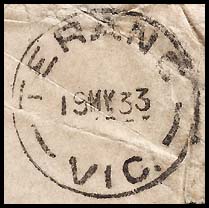 19 May 1933. Used on AB-EO-8C. |
|
| The earliest evidence of the operation of the Warrnambool Telegraph Office is a telegram transmission form (VC-TO-5) used for a message sent to Melbourne (?) on 29 October 1873. | |
| The Office was issued with four formats of date stamps for use with Telegrams: | |
|
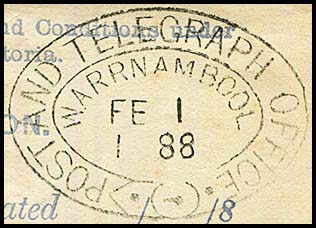 1 February 1888 (earliest recorded date). |
|
|
A steel circular TELEGRAPHS WARRNAMBOOL date stamp (SC1-T).
|
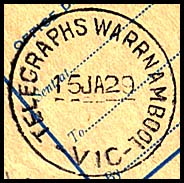 15 January 1929. Used on AB-DO-4A.
|
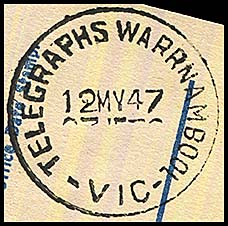 12 May 1947. Used on AW-DO-9B.
|
|
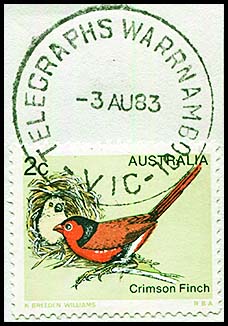 3 August 1983. |
|
Usual postal date stamps for Warrnambool which were also used on telegrams. |
|
|
